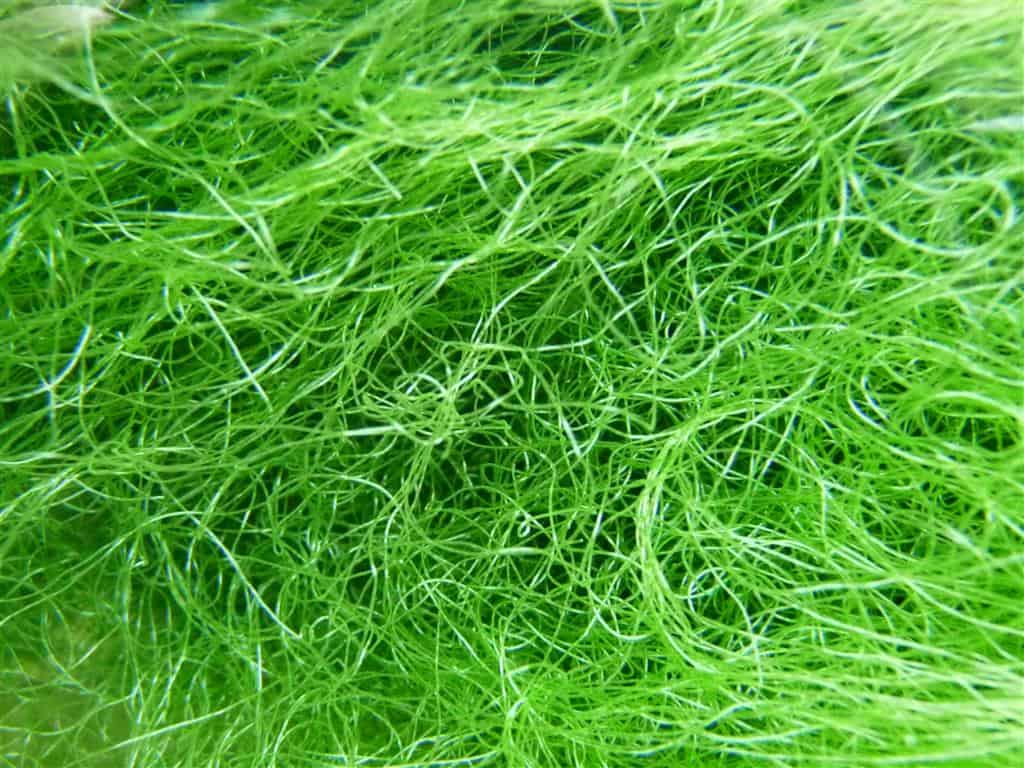REFUGIUM WITHIN THE TRITON METHOD
ALGAE AND THE REFUGIUM WITHIN THE TRITON METHOD
ALGAE AND THE REFUGIUM WITHIN THE TRITON METHOD
By: Scott Fellman & Tim Caldwell
As more and more reefers embrace the “Triton method” and look for ways to enhance coral growth and minimize environmental variables within their systems, the concept of nutrient export becomes more and more important. One of the easiest and most natural ways to support nutrient export in a Triton system is to grow and harvest macro algae in a dedicated section of your sump, or in a refugium.
Yes, the refugium… The seemingly much-‐maligned idea-‐ sent out to pasture for no apparent reason, is not dead…and it shouldn’t be! For some reason, the concept of a vegetable refugium fell out of favour with the hobby “in crowd” not too many years back, as more sexy-‐sounding concepts and methods, like “ULNS”, biopellets, and “carbon dosing” took centre stage. As with so many things in this hobby, the pendulum of trendiness swings back and forth, and seemingly old and humble concepts seem to work quite well; thus the refugium is ready for a fresh look.
THE CONCEPT OF MACRO ALGAE FOR NUTRIENT EXPORT
Macro algae are one of the most adaptable life forms in the ocean. There are numerous species, many of which find their way into our aquariums. Some grow out of live rock or other materials collected from the reefs, while others are deliberately collected and propagated by hobbyists. For our purposes, we will focus on the more popular varieties that are found in the hobby and trade. Many are both useful and aesthetically pleasing, taking on growth forms and colours that are quite appealing.
The whole premise of a vegetable refugium is to cultivate rapidly growing yet stable macro algae that compete for excess nutrients that would otherwise fuel nuisance algae and diminish water quality. Although macro algae do utilize some of the same nutrients and trace elements as corals, they perform the valuable function of reducing some of the less desirable substances that accumulate in a closed reef system. So, to answer your question (you were going to ask, right?): The macro algae will have a far more positive impact on your reef than any possible negative consequences resulting from “competing” with your corals for nutrients.
When you harvest or prune macro algae, you are physically removing it and the nutrients it has taken up, from your system permanently. This makes it perfect for nutrient export in closed reef systems. In addition, growing macro algae use the nutrients and trace elements available to them and convert them into numerous organic substances in their metabolic processes, including amino acids, sugars, and vitamins-‐ all of which are utilized by bacteria and other organisms residing in the aquarium. And of course, some of the microorganisms such as plankton are a food source for corals and other life forms in your system. It is even postulated that growing macro algae in closed systems generate beneficial chemical substances directly into the water column.
General requirements are “reef level” water parameters, and sufficient light to encourage strong growth. Most macro algae will do fine under 5,000K-‐10,000K spectrum, and this can
be achieved with a variety of lighting formats, depending upon your budget , layout, and operational parameters. I’ve grown plenty of wonderful, healthy macro algae with inexpensive T5 or compact fluorescent light fixtures intended for other uses-‐ and more recently, with household LED under shelf lights and such with similar great results. It’s really a matter of what fits your space and your budget. With that in mind though Triton recommends the use of T5 or CFL at a colour temperature of 6500k as this will supply the correct light for all eventualities (more on that later).
Lighting photoperiod should be around 10-‐12 hours, and should be run opposite of the display tank lighting photoperiod. This will assist in preventing pH swings from occurring at night when corals are done photosynthesizing for the day. So the “reverse cycle” keeps the pH value stable and supplies the CO2 for the corals’ zooxanthellae during the day… All good stuff!
How much macro algae do you need? Well, Triton suggests that you incorporate as large a macro algae section as is practical, with a minimum of 10% of the volume of the display tank being optimal. That’s a significant algae bed, right? Although in all likelihood, you’ll utilize maybe one or two species, it’s encouraged to incorporate as many species as possible in the refugium, as each macro algae has different nutrient absorption properties/capabilities at any given time. Diversity is an advantage when viewed in this light!
Your system will go through different stages through time with regards to the available nutrients to the macro algae, this will suit one species more than others and therefore one species of algae will become dominant. This does not usually cause any other species to die off more lay dormant for a time.
There are many triggers that can cause a “shift” in the natural environment of your system, whether it is a change in food, or a change in livestock, or even a change in season (think pollen).
Once a shift has taken place then your refugium should be ready for this change and hopefully have a species of algae ready in the background laying dormant ready to take up the baton and handle the “new” nutrient demands.
This process can been seen in practice when say a refugium is only stocked with Chaetomorpha and while the nutrient control has been good and growth of the algae satisfactory for no apparent reason the algae growth slows down to a stop, maybe even begins to die back. This is purely down to the system “shifting” from one nutrient environment to another, and the new environment is no longer preferable to the Chaetomorpha.
This is also where suitable algae lighting for all algae species plays it’s part. While your lighting may have been more than sufficient to grow Chaeto, when the shift comes and the responsibility gets passed on is your lighting going to be suitable for the new dominant species.
Triton’s suggestion for a macro algae refugium is that the water from the aquarium enters the sump directly into the algae section via the overflow. It is not recommended to use filter socks, because it is theorized that they remove beneficial “ingredients” that the algae and other life forms in the aquarium utilize for growth. If you find that excessive amounts of detritus are settling on your macro algae bed, it can be removed with a siphon. A small powerhead could be added to the compartment to keep the algae “tumbling” somewhat, which encourages growth at the base, as well as prevents the algae from being smothered by detritus. It is not recommended to use sand or other substrate in this setup, as the purpose is to encourage macro algae growth.
CAULERPA LOVE OR HATE?
Depending on where you are in the world will most likely influence your opinion on Caulerpa and it’s uses in the refugium.
Although it can be kept healthy and happy for long periods of time if provided with a nutritional source (i.e. the metabolic products from your reef, among other things) and regularly harvested, it can become problematic if allowed to grow unchecked, and unharvested in your refugium or reef.
And, if that’s not enough to make you dislike these macro algae, the fact that a number of states in the US have made it illegal to possess or distribute. The last thing you’d ever want to have happen is for this stuff to get into native water systems. It has a track record of invasive behaviour throughout the world, and extreme care must be exercised when contemplating keeping this macro algae in your aquarium.
In the UK though it is a very popular macro algae and used extensively.
However, they tend to grow and grow and grow until, quite literally, they run out of food, in this case, nitrogen and phosphorous, mainly, and to a lesser extent, calcium, magnesium, iron, and carbon. That’s why regular “pruning” and harvesting of this algae is so important. Once the algal population can no longer be sustained by the food supply, the response of this algae is to enter the “sexual phase”, or “sporulation phase” of their life cycle, which results in a massive breakdown of their cellular material and a release of sexual products and their cellular contents into the water column…a potentially disastrous event in the closed system.
COMMON ALGAE SPECIES SUITABLE FOR THE REFUGIUM
Chaetomorpha

The current darling of the reef-‐keeping world is Chaetomorpha. Last time I checked, there were 9 species of Chaetomorpha recognized by science, but the one that we encounter most often in the hobby/trade is C. linum. This distinctive macro algae looks for all the world like a pot scrubber pad, and has a dense matrix structure that makes it valuable as a support for communities of small crustaceans and invertebrates, ranging from amphipods to bristle worms and even small starfish.
Sort of a “mini refugium” of it’s own. Apparently, for all its usefulness, no one really likes to eat the stuff. Even the most gluttonous Tangs seem to totally ignore it, except maybe to forage through it looking for micro algae or something more tasty. That being said, it doesn’t really lend itself aesthetically to being kept in the display aquarium anyways, and its free-‐floating nature doesn’t help! That being said, it’s arguably the best choice for nutrient export in closed systems. It grows easily and rapidly, is not at all difficult to contain in a refugium or lighted section of your sump, and is super easy to harvest. In addition, it’s not likely to release sexual products into your water column, and is great “trade bait” at frags swaps!
Ulva

Here’s one that is equally spectacular for nutrient export, and has the added benefit of being a tasty treat for your herbivorous fishes! Ulva, known commonly as “Sea Lettuce” is a very different looking macro algae. It resembles a flat piece of green translucent plastic, and does not have any real point of attachment to substrate. It’s essentially a free-‐ floating species which sort of attaches itself to rocks by virtue of it’s two-‐cell-‐layers-‐thick structure.
Ulva is really easy to grow. The main challenge is to keep it from floating where you don’t want it-‐ like pump intakes and overflow weirs.
Best to keep it in a little strainer basket, like the plastic pasta or vegetable strainers you can get at discount stores. Supply it with some decent light and it grows like crazy. You can harvest it for trade, sale, or the occasional treat for your Tangs! An important note is that you should have sufficient flow through in your algae chamber or refugium so that detritus and such doesn’t settle on the macro algae.
Halymenia

Halymenia, also known as “Dragon’s Tongue”, is another effective red macro algae for nutrient export, and has the added advantage of being quite attractive-‐ enough so to warrant inclusion in a display if you’re so inclined. However, for our purposes, we’re talking about a macro algae that can be harvested with regularity, and, for all practical purposes, this is more easily accomplished in a refugium or sump. It’s actually a pretty economically valuable macro algae, fetching a pretty good amount when offered up for sale…something to think of!
This species doesn’t grow quite as quickly as some of the other macro algae you’ll encounter, yet it still can grow at a sufficient speed and in a quantity that makes it valuable enough for nutrient export purposes. It is sometimes found attached to rocks, other times, floating freely just like Ulva.
Halimeda sp.
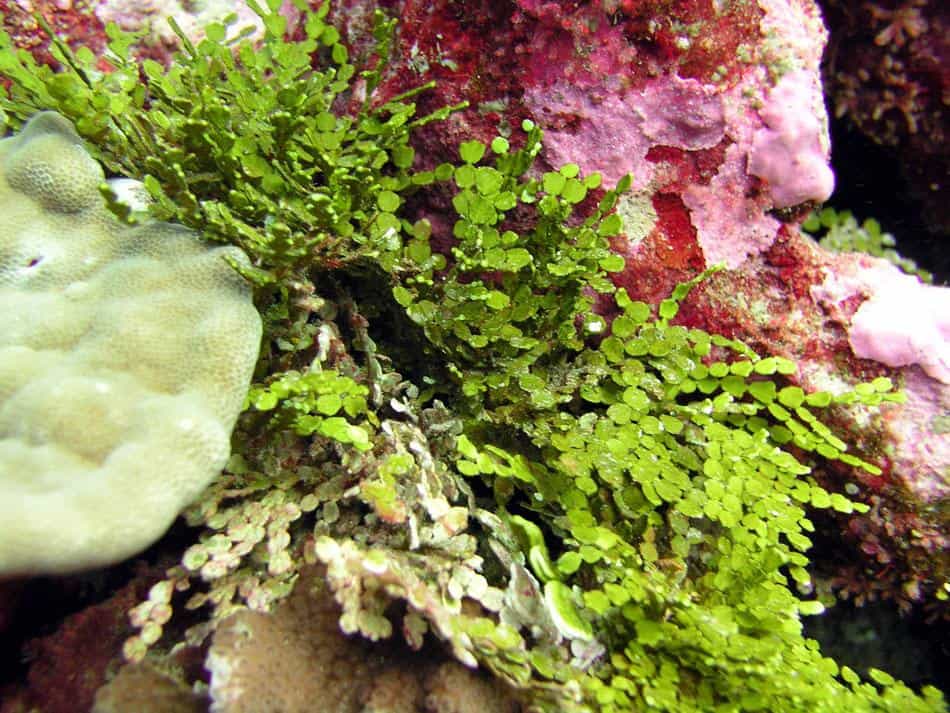
Although less commonly utilized for the sole purpose of nutrient export, Halimeda is a great macro algae to work with nonetheless. It’s reasonably stable, easy to care for, grows rapidly, and is quite attractive. It’s a calcareous macro algae, synthesizing calcium carbonate directly from the water column.
Of course, it will also deposit calcium into the reef system. In fact, in some studies, large tracts of the substrate in parts of the Great Barrier Reef were found to be comprised almost exclusively of Halimeda fragments. My main hesitancy to recommend Halimeda as a refugium resident is that this algae removes calcium and carbonate from the system and essentially acts like a stony coral in this regard. One could make the leap of faith that this macro algae acts as an “on site calcium/alkalinity indicator”, as it will definitely be effected by-‐ and affect-‐these parameters in your system.
Chlorodesmis sp.
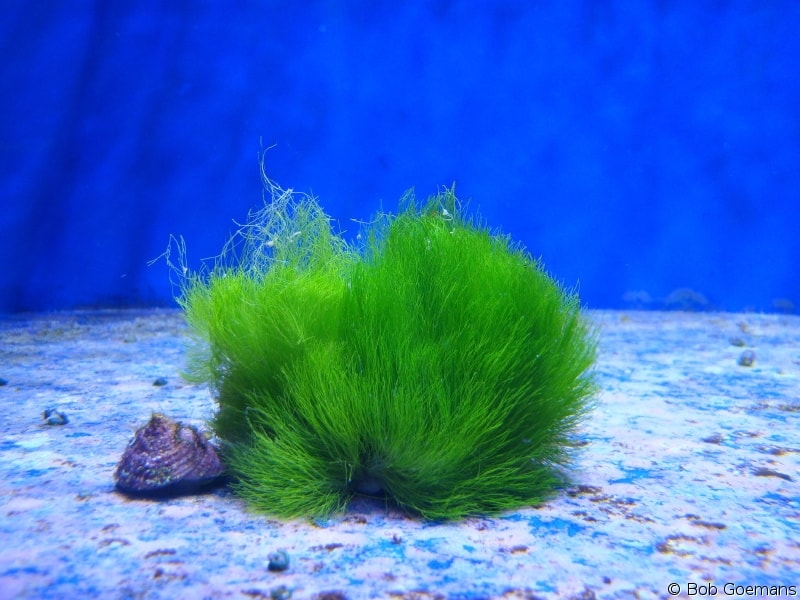
Often referred to in hobby circles as “Maiden Hair” or “Turtle Weed”, this green filamentous macro algae is found in thick clumps, attached to rocks, and is prolific and dense growing. It serves as a haven for crustaceans such as amphipods and copepods, and is rather distasteful to predators, so it’s durable, too! It does tend to fare better in brighter lighting, so if you’re illuminating your sump/refugium with more intense light, all the better! It also likes a decent amount of water movement, so it’s perfect for a higher-‐flow area of your refugium. It’s easy to prune by simply pulling out some of the material from the rock that it’s growing on.
Ochtodes sp.

Another more-‐or-‐less free-‐floating macro algae, this one is actually a gorgeous bluish-‐ purple colour, and has some really cool aesthetic features! It features coarse and bushy structures with compact branches. It seems to take on a darker colour under lower light conditions, which is interesting.
Nonetheless, it grows rapidly in typical “reef” refugium conditions, and is relatively undemanding as macro algae species go.
Hypnea sp.
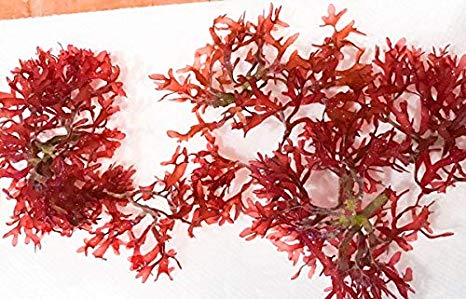
This is a cool species because, once again-‐ it’s just plain attractive. It grows quite rapidly under ideal circumstances, which include moderate to bright light and typical nutrient-‐ laden reef water. this algae can grow very quickly once settled in, and thus makes it an excellent candidate for nutrient export in a vegetable refugium. And, the fact that it’s being propagated in quantity by facilities such as ORA mean that it’s readily available and high in quality. An excellent addition to a diverse macro algae collection!
Caulerpa Mexicana

Otherwise known as Feather algae or Fern algae this algae grows readily in the refugium, so much so that it can pretty much be watched growing if you so desired!
Caulerpa Prolifera
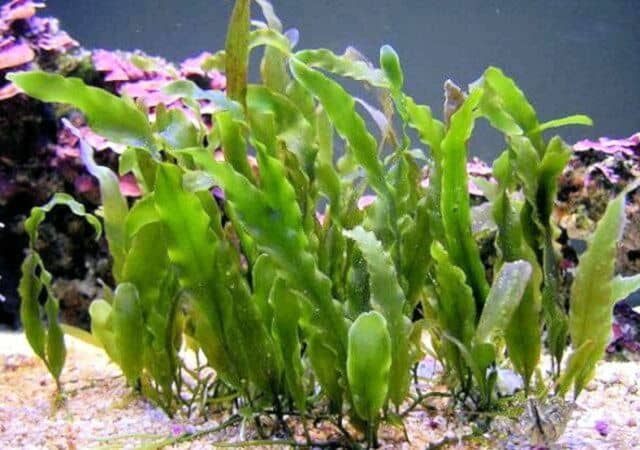
Otherwise known as blade algae, another fast growing Caulerpa, benefits from a faster flow enabling it to grow long lush green leaves.
Caulerpa Racemosa
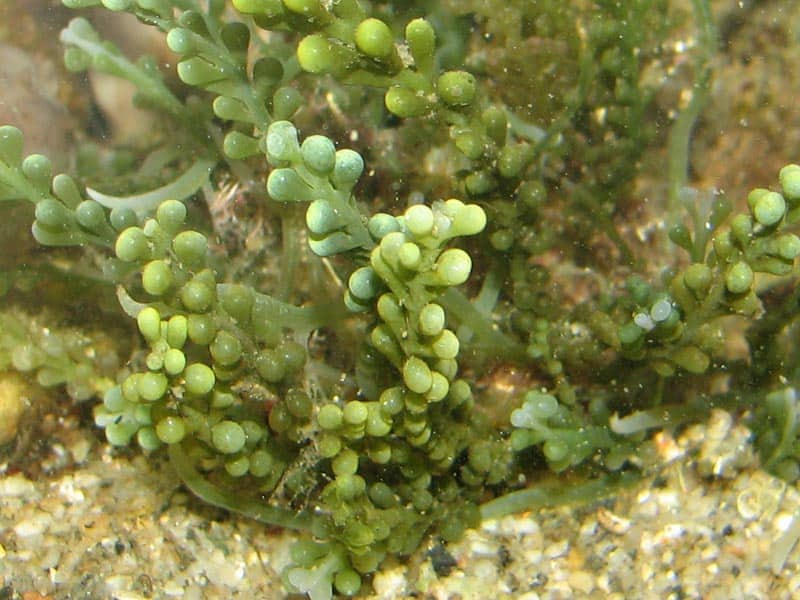
Otherwise known as Grape algae, often named as the riskiest of all the Caulerpa species for going sexual, however a good maintenance / pruning regime will ensure that the risk is reduced to a minimum. Again a fast growing algae and one that can quickly swamp corals should it make it’s way to the main display..
Caulerpa Taxifolia
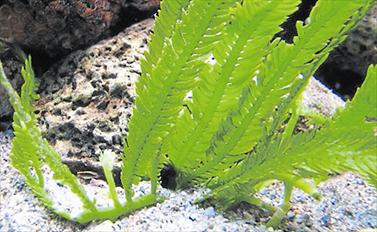
Otherwise known as Feather algae, very similar in appearance to Mexicana. You guessed it another fast growing Caulerpa species!
Caulerpa Serrulata

Otherwise known as Sawblade algae, this algae grows in attractive layers, corkscrewing in appearance.
With all the Caulerpa species it is important to ensure that unless you want it to it doesn’t make it’s way into the main display as they can quickly swamp corals, I’ve personally experienced Racemosa choke out my prized Forest Fire Digitata from the base ;(. So if you spot any get the tweezers out and either relocate it to the refugium or the bin if you are not a fan of that particular species..
CONCLUSION
Of course, there are many, many other species of macro algae that you can utilize in a vegetable refugium. In fact, if you’re not careful, you might just end up with another aquarium just for macro algae…an interesting “sub-‐hobby” of its own! This has been just a quick survey to scratch the surface and whet your appetite about the possibilities that abound out there. The bottom line is that you are attempting to foster a growth of macro algae to enhance your miniature aquatic environment. The utilization of beneficial macro algae is just another component that can lead to success with the Triton method.

